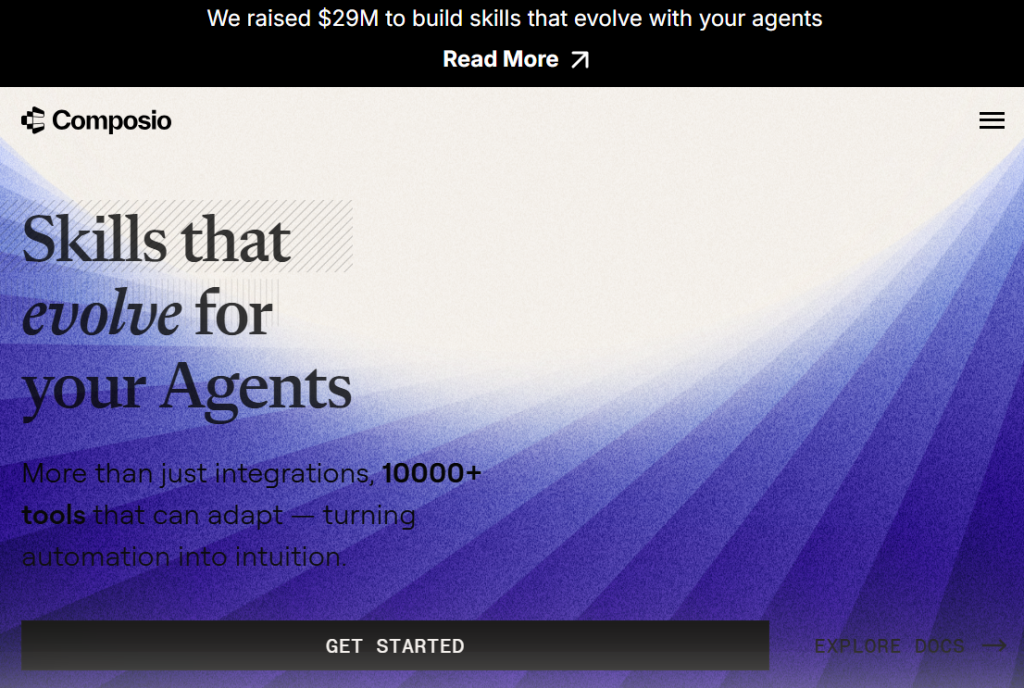Composio Raises $25M Series A to Power Developer-Native Workflow Integrations
July 28, 2025
byFenoms Start-Ups

Composio, the platform transforming how developers build and scale integrations, has raised $25 million in Series A funding to build the world’s most developer-friendly integration infrastructure. The round was led by Lightspeed Venture Partners, with participation from a stellar cast of angels and operators including Guillermo Rauch (Vercel), Dharmesh Shah (HubSpot), Gokul Rajaram, Soham Mazumdar, SV Angel, Blitzscaling Ventures, Agent Fund, Elevation Capital, and Together Fund.
Founded by Soham Ganatra and Karan Vaidya, Composio is tackling a pain point that haunts nearly every modern software team: how to ship and manage integrations without sacrificing velocity, reliability, or developer sanity.
What Composio Does
Composio offers a developer-first platform for building, deploying, and maintaining SaaS integrations. Its core value proposition? Let dev teams integrate with third-party APIs, CRMs, task managers, and internal tools without ever touching OAuth flows, rate limits, token refresh logic, or brittle custom scripts.
Key features of the platform include:
- Prebuilt OAuth flows and refresh token handling
- Secure credentials vault with permission scoping
- Unified APIs across popular apps (Slack, Notion, GitHub, Salesforce, etc.)
- Event listeners and workflows to trigger custom app logic
- Integration monitoring, logging, and retry systems out of the box
In essence, Composio is building the “Vercel for integrations” - a developer-native abstraction layer that treats integration as a primitive, not an afterthought.
The Integration Tax Is Real - And Growing
It’s often said that “every SaaS company becomes an integration company.” What’s less discussed is how much integration debt teams accumulate along the way.
Engineers lose an average of 30–40% of development cycles building and maintaining integrations - most of which provide no core differentiation to the product itself. They’re table stakes, not moats. And yet they break constantly.
Composio’s vision is clear: strip integrations down to their essence, and offer them as building blocks - secure, observable, scalable - from day one.
Where the Real Unlock Lies
What separates developer tools that survive from those that dominate? Workflow alignment.
It’s not enough to be dev-friendly - you have to be dev-native. The most enduring infrastructure products (like Stripe, Vercel, and Retool) didn’t just offer functionality. They fit directly into developer rituals: local dev, CI/CD, observability, and iterative deployment.
Composio’s edge is exactly this. It doesn’t force you to adapt to some clunky new interface or intermediary platform. Instead, it fits right into your stack:
- SDKs and client libraries for Node, Python, Go, and more
- CLI tooling for managing secrets and OAuth workflows
- Support for serverless environments like Vercel, Netlify, and AWS Lambda
- Webhooks and event-driven architecture for real-time triggers
This philosophy - meet developers where they are, and get out of the way - is what turns integration from a tax into a feature.
And here's something many founders miss: the faster you can delegate non-core engineering (like auth, retries, logs, and rate limits), the more surface area you unlock for innovation. Most startups fail not because they can’t build, but because they’re building the wrong things. Platforms like Composio help keep your team focused on product-market fit, not integration plumbing.
Why This Timing Matters
The Series A round comes at a time when integration complexity is exploding across sectors. The average mid-sized SaaS company uses over 130 SaaS tools internally (BetterCloud, 2024), while their customers expect seamless interoperability between platforms.
And the integration market is catching up:
- The iPaaS (Integration Platform as a Service) market is projected to reach $13.9 billion by 2027, growing at a CAGR of 32.4% (Markets and Markets, 2024).
- Over 70% of enterprise software buyers cite integration capabilities as a top-three priority when selecting tools (Gartner, 2023).
- Developer Experience (DevEx) has become a key metric for tooling adoption - 51% of teams said poor integration support was a blocker in their last procurement decision (Postman 2024 Dev Survey).
Meanwhile, the rise of vertical SaaS, AI tools, and microservices means composability is no longer optional - it’s table stakes. And composability starts with clean, maintainable integration layers.
What’s Next for Composio?
With fresh funding in the bank, Composio is planning to:
- Expand its catalog to support 500+ popular SaaS apps
- Launch deeper platform support for event-driven workflows
- Release enterprise-grade access control and team management tools
- Build partnerships with leading low-code/no-code platforms
- Double down on documentation, developer onboarding, and SDKs
The long-term goal? To become the default integration layer for every modern developer stack.
As more companies adopt composable architectures, Composio wants to be the connective tissue between apps, services, workflows, and data - without making developers fight the infrastructure.









